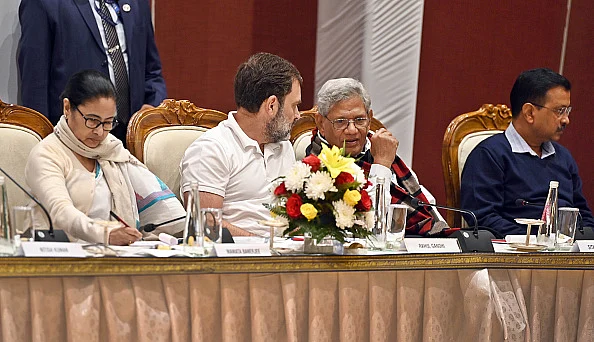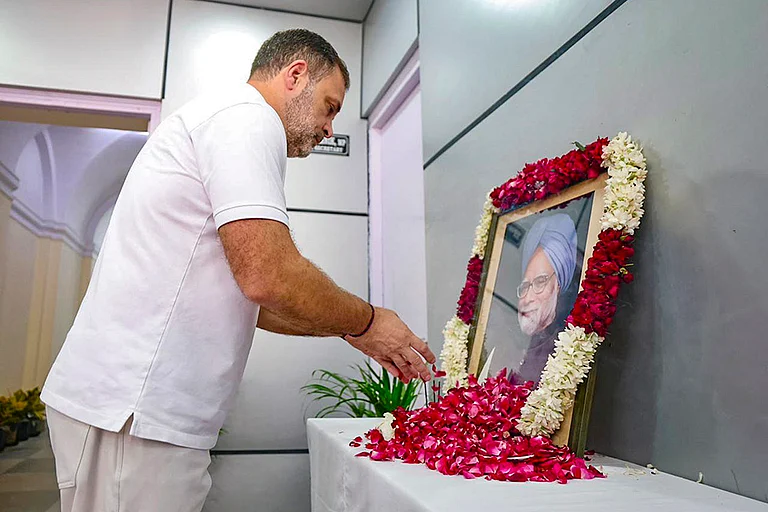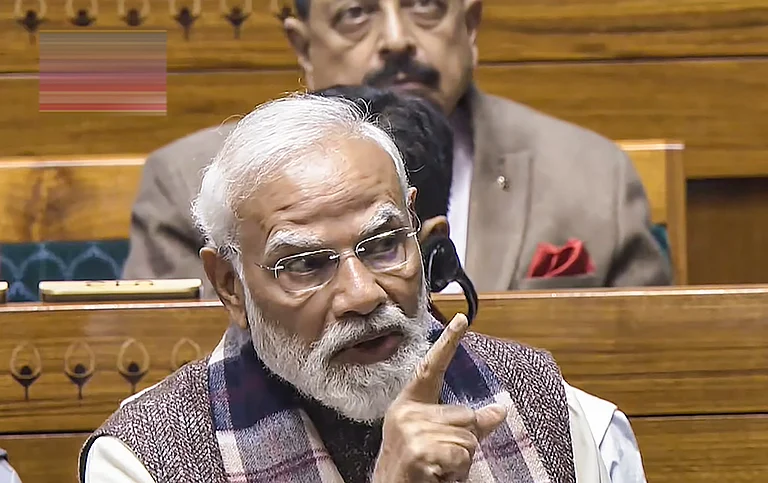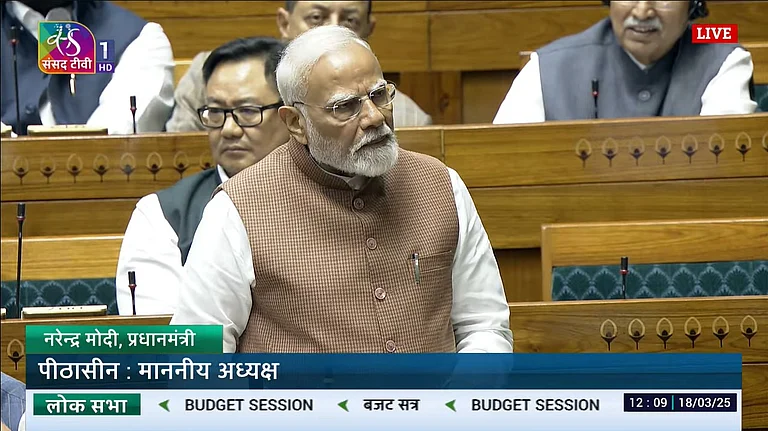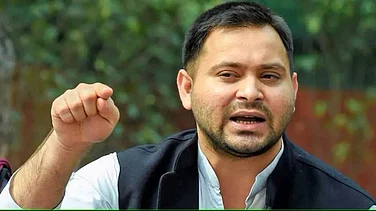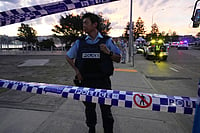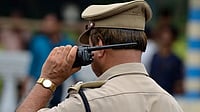Last year, after months of criss-crossing of the country by Opposition leaders, 26 parties came together to form the INDIA bloc. The message of the bloc was clear: it is INDIA versus NDA and INDIA versus Narendra Modi.
While 26 parties of the INDIA bloc converged in Bengaluru to announce the formation of the Opposition's alliance, the Bharatiya Janata Party (BJP) held a meeting of its own National Democratic Alliance (NDA) the same day in Delhi. A total of 38 parties —more than the parties in the INDIA bloc— attended the NDA meeting.
While the BJP claimed that it had a broader alliance as NDA had many more parties than the INDIA bloc, the reality was for all to see. Of approximately 335 MPs that NDA has in Lok Sabha, the BJP has the lion's share of 290. There are just two more parties with MPs in the double digits. On the other hand, the Lok Sabha strength of the INDIA bloc's parties is much more even.
The differences like the alliances also show the nature of the contest in the 2024 general elections. While the premise of the INDIA bloc is that all the constituent parties will collectively bring all non-BJP voters under one umbrella to override the tally of the BJP riding on the popularity of PM Modi and resurgent Hindutva, the BJP on the other hand is singularly driving the NDA.
Here we explain how the INDIA bloc and NDA stand numbers-wise and what are the unique strengths and weaknesses of the two coalitions.
INDIA Vs NDA In Numbers
As things stand today, the Bharatiya Janata Party (BJP)-led National Democratic Alliance (NDA) has around 335 Lok Sabha MPs. Of them, the BJP has 290.
Of the 38 parties comprising the NDA, only two parties other than the BJP have MPs in double-digits: Janata Dal-United (JD-U) —which dumped INDIA to join NDA last month— has 16 MPs and Eknath Shinde's Shiv Sena faction has 13. The rest of the parties bring single-digit numbers to the NDA's kitty.
Here are the single-digit numbers that the rest of the parties bring to the NDA:
Lok Jan Shakti Party (LJJP) : 6
Apna Dal-Soneylal (AP-S) : 2
Rashtriya Lok Janshakti Party (RLJP) : 5
Lok Janshakti Party (LJP) : 1
Nationalist Democratic Progressive Party : 1
Mizo National Front : 1
The following parties do not have a single MP: National People's Party, All Jharkhand Students Union, Sikkim Krantikari Morcha, Indigenous People's Front of Tripura, Naga People's Front, Republican Party of India, Asom Gana Parishad, Pattali Makkal Katchi, Gorkha National Liberation Front, Asom Gana Parishad, Pattali Makkal Katchi, Tamil Maanila Congress, United People's Party Liberal, Suheldev Bharatiya Samaj Party, Shiromani Akali Dal (Sanyukt), Maharashtrawadi Gomantak Party, Jannayak Janta Party, Prahar Janshakti Party, Rashtriya Samaj Paksha, Jan Surajya Shakti Party, Kuki People's Alliance, United Democratic Party (Meghalaya), Hill State People's Democratic Party, Nishad Party, All India NR Congress, Hindustani Awam Morcha, Jana Sena party, Haryana Lokhit Party, Bharath Dharma Jana Sena, Kerala Kamaraj Congress, Puthiya Tamilagam, Gorkha National Liberation Front
On the contrary, INDIA bloc has parties stacked much more evenly. Unlike the way BJP leads NDA, INDIA bloc is not 'Congress-led' even though it is the single-largest party of the bloc and party chief Mallikarjuna Kharge is the bloc's chairperson.
Here is how the parties of INDIA bloc stand in Lok Sabha:
Congress : 48
Dravida Munnetra Kazhagam : 24
Trinamool Congress : 22
Shiv Sena (UBT) : 06
Nationalist Congress Party (NCP) : 05
Samajwadi Party : 03
J&K National Conference : 03
Communist Party of India (Marxist) : 03
Indian Union Muslim League : 03
Aam Aadmi Party : 01
Viduthalai Chiruthaigal Katchi : 01
Kerala Congress (M) : 01
Revolutionary Socialist Party : 01
The 13 parties together have 121 MPs in total. The rest of the 13 parties do not have a single MP.
When the alliance was formed, INDIA also had 16 MPs of Nitish Kumar's JD (U), which further boosted the bloc's numbers to 137 and diversified the tally. Since the formation of the bloc was announced, Rashtriya Lok Dal (RLD) has also left to join the BJP-led NDA. However, the party does not have a single Lok Sabha MP.
Hits And Misses Of INDIA Vs NDA
The basic premise of the INDIA bloc is that it will converge all non-BJP voters on one candidate to defeat the BJP. The formula was first floated by West Bengal Chief Minister and Trinamool Congress (TMC) supremo Mamata Banerjee. She said that the party that's strongest in a region —such as TMC in West Bengal and Samajwadi Party in Uttar Pradesh— should be the primarily Opposition face in that region and all Opposition parties should work to consolidate all non-BJP voters on that party's candidate.
"In this situation, Whoever is strong in some place, in their region, they should fight together. Let's take Bengal. In Bengal, we [Trinamool] should fight. In Delhi, AAP should fight. In Bihar, they are together. Nitishji [JD-U], Tejashwi [RJD], and Congress are together. They will decide. I cannot decide on their formula. In Chennai, they [DMK and Congress] have a friendship and they can fight together. In Jharkhand also, they [JMM-Congress] are together and in other states also. So it is their choice," said Mamata last year ahead of the formation of INDIA bloc, adding that Congress is strong in around 200 seats and she would support the party in those seats.
In this way, whatever tally the INDIA bloc manages to get in the 2024 Lok Sabha elections or whatever numbers they have at the moment is a much more collaborative effort as, except for Congress, all the parties are regional parties and their strengths are much more even. For example, while Congress is the main force against the BJP in Uttarakhand, Rajasthan, Madhya Pradesh, or Chhattisgarh, it's Rashtriya Janata Dal (RJD) in Bihar, Aam Aadmi Party (AAP) in Delhi and Punjab, DMK in Tamil Nadu, TMC in West Bengal, etc.
While this looks good on paper, there are several internal contradictions in the bloc. The foremost being the resentment towards the Congress of regional parties, which has resulted in TMC contesting solo in West Bengal, AAP going all by itself in Punjab, and Akhilesh Yadav unilaterally announcing the number of seats for the Congress in Uttar Pradesh. There is also the issue of the thinning of the ranks as JD (U), whose Nitish Kumar was the architect of the bloc, has ditched the coalition, and RLD that has influence in West UP has also jumped ship.
On the other hand, while BJP appears too strong to be challenged on paper and is assured to be the single-largest party in any case, there are issues nonetheless for the saffron party. For one, unlike the INDIA bloc, the BJP does not have partners it can count in. In case the tally of the BJP falls from its current strength of 290, it does not have any partner that can provide a cushion for the numbers lost as there are just two parties —JD (U) and Shiv Sena— with MPs in double digits.
Then, there is also the issue of the BJP peaking in its bastion of North India. Even though PM Modi and the BJP have projected confidence of winning 370 seats in the upcoming elections, observers have highlighted that the BJP has peaked and may find it difficult to further expand its tally.
In the 2019 general elections, the BJP-led NDA won 64 of the 80 seats in UP, all the 26 in Gujarat, all 25 in Rajasthan, 28 of 29 in Madhya Pradesh, nine out of 11 in Chhattisgarh, 12 of 14 in Jharkhand, and all the 10 seats in Haryana. With such a peak in its core support area of North and West India, the BJP is unlikely to peak further, particularly in the context of Opposition unity of INDIA bloc — even though BJP has won three states after the emergence of INDIA bloc.
"Even at the height of its popularity in 2019, it [BJP] got 303 seats, 31 more than the majority figure in the Lok Sabha. In 2024, as it stands today, it won’t have anything more to add to what it had already offered in 2019 to the increasingly transactional voters with ever-increasing demands," noted DK Singh in The Print.






